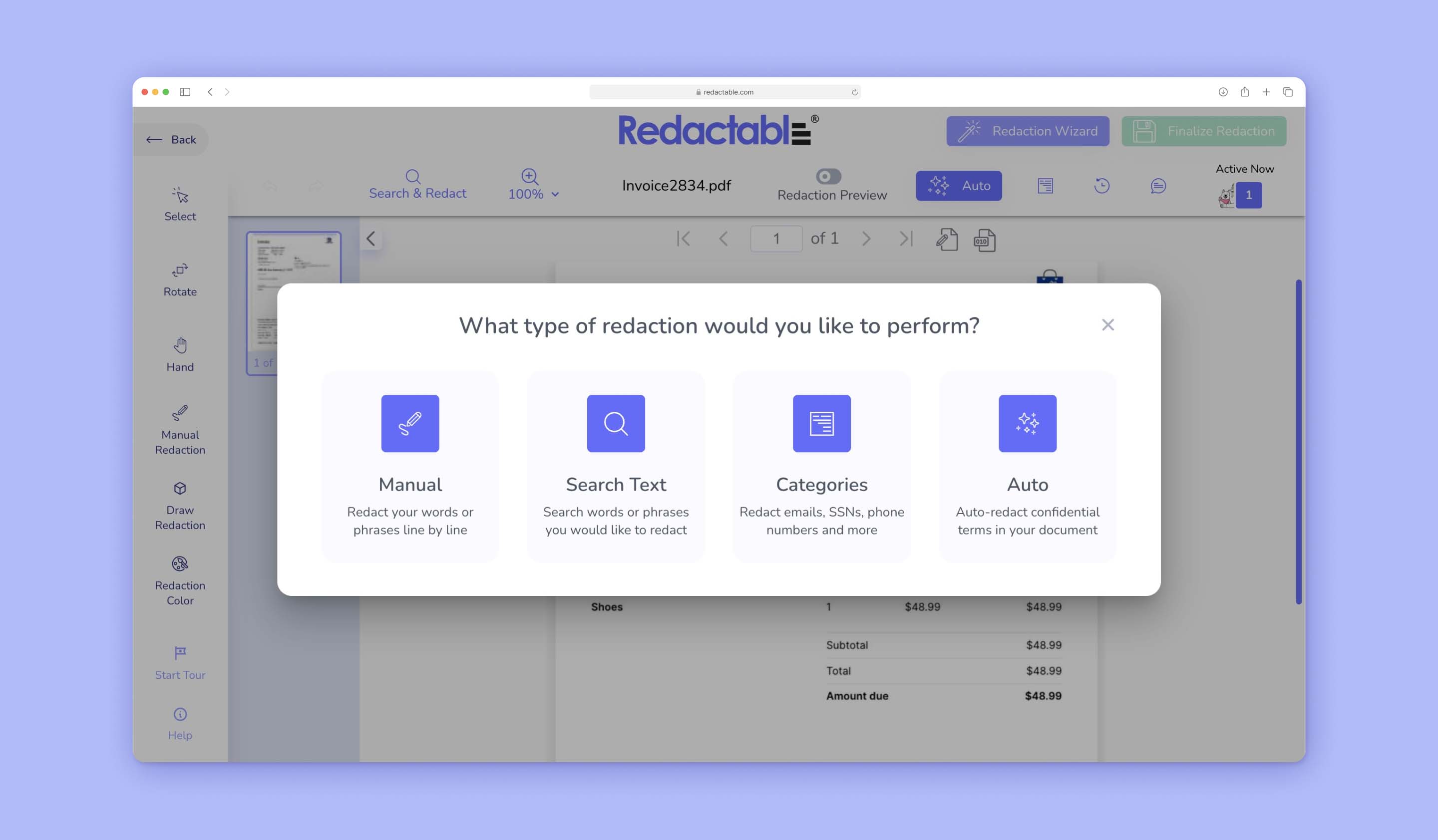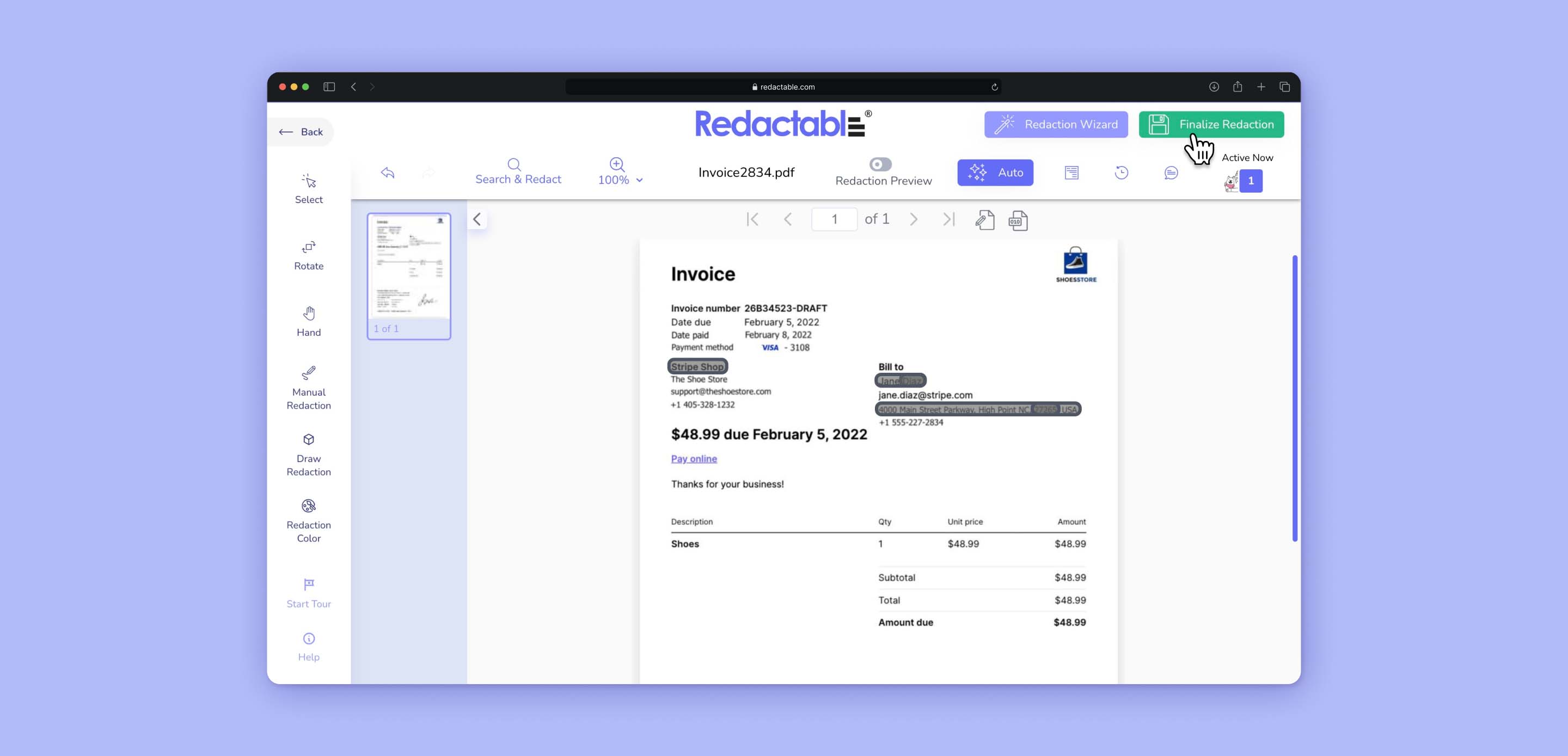Redaction in law means removing or hiding sensitive information from documents to protect privacy and comply with regulations. This process ensures that personal, financial, or confidential data isn’t exposed when legal documents are shared or published.
Why legal documents need redaction
Redaction is your first line of defense against exposing sensitive information in legal documents. As your firm handles growing volumes of confidential client data, properly securing this information is essential for maintaining trust and avoiding costly mistakes.
Privacy protection
Each redaction acts as a shield, blocking unauthorized access to private details that could leave clients vulnerable to identity theft and fraud. In today's environment where data breaches are commonplace, thorough redaction provides security for both your clients and your practice.
Beyond protecting client privacy, proper redaction helps your firm stay compliant with strict legal standards, avoiding the potentially severe penalties and reputational damage that can result from oversight.
Legal requirements
Laws and regulations require the redaction of sensitive information in legal documents to uphold privacy and maintain security standards. Failure to comply with these mandates puts your practice at risk of substantial penalties while potentially exposing client data to unauthorized access. Here are some key regulations:
Legal professionals must handle sensitive data with care to avoid penalties. For example, healthcare providers can face serious fines under HIPAA for failing to redact patient information, while organizations managing data of EU residents must meet GDPR's stringent standards or face severe financial consequences. These regulations don't merely suggest best practices—they mandate specific redaction requirements that demand consistent, verifiable compliance.
Law information that requires redaction
Legal documents often contain sensitive data that must be redacted to protect privacy and comply with regulations.
Personal Information (PII)
Personally Identifiable Information (PII) needs to be redacted according to legal requirements. Here are some common examples:
Filing documents with unredacted PII can lead to serious privacy breaches. Health records, in particular, require extra care to meet compliance standards.
Health Information (PHI)
Protected Health Information (PHI) must be redacted to comply with HIPAA and safeguard patient privacy. A stark reminder of the importance of this came with the 2020 Anthem case, where a data breach impacted nearly 79 million people, resulting in a $16 million settlement.
PHI that requires redaction includes:
- Patient medical records
- Treatment details
- Healthcare provider information
- Insurance data
- Medical device identifiers
- Medical trial records
Failing to redact PHI can have severe legal and financial consequences.
Financial data
Financial information requires meticulous redaction to shield clients from fraud and identity theft. Even a single exposed account number can compromise financial security, creating liability for your firm while damaging client trust.
Key financial details that demand thorough redaction include:
- Bank account numbers
- Credit card details
- Investment account information
- Wire transfer records
- Tax return data
- Loan application forms
Financial records often contain multiple layers of sensitive information that standard redaction methods might miss, including metadata and embedded content. Proper redaction of financial documents requires technology specifically designed to identify and permanently remove all traces of financial data, not merely obscure it visually.
Redaction in court: Secure document handling methods
Once sensitive information requiring protection is identified, legal professionals have several approaches to choose from for redaction.
Manual redaction
Using black markers, correction fluid, or PDF editor tools for manual redaction can be time-consuming, and prone to mistakes. This outdated approach is not only inefficient but potentially catastrophic for confidentiality.
The problems with manual redaction methods are twofold:
Physical Redaction Failures: Black marker redactions can become transparent when scanned or when certain lighting or digital enhancement techniques are applied, exposing supposedly hidden information. What appears secure to the naked eye may be completely visible in digital form.
Digital "Drawing" Failures: Using design software or PDF editors to cover sensitive information with black boxes or highlights merely obscures the text visually while leaving the underlying data fully intact and accessible.
A stark example of this second failure occurred in January 2019, when lawyers for former Trump campaign chair Paul Manafort submitted court filings with black boxes drawn over sensitive text. The redaction failed because they didn't remove the underlying data, allowing journalists to simply copy and paste the "hidden" text, revealing confidential connections to Russian intelligence.
Professional redaction software
Modern redaction demands modern solutions. Professional redaction software leverages AI to identify and permanently remove sensitive content with exceptional accuracy while dramatically reducing the time legal teams spend on this critical task:

"It’s AWESOME! I love it and have already recommended it to my colleagues in law." - Philip J. Berenz, Berenz Law Network PC
Outsourced redaction
Outsourcing redaction work might seem like a convenient solution when facing large document backlogs or tight deadlines, but this approach introduces significant risks and inefficiencies that legal professionals should carefully consider.
Hidden risks of outsourcing
When sensitive documents leave your control, you introduce multiple points of vulnerability. Each transfer increases the risk of data breaches or unauthorized access. Third-party vendors rarely offer the same level of security protocols that you maintain within your own firm, potentially compromising client confidentiality.
Cost considerations
Outsourced redaction services typically charge premium rates, especially for urgent projects. These vendors often rely on labor-intensive manual methods, resulting in higher costs without necessarily providing superior quality. For example, a standard 500-page document might cost significantly more to outsource than to process in-house with automated tools.
Timeline challenges
While outsourcing promises to save time, the reality often includes:
- Extended timelines for secure document transfer
- Communication delays between teams
- Multiple review cycles to verify completeness
- Additional time to reintegrate documents into your workflow
These delays can be critical when dealing with court deadlines or time-sensitive client matters.
The in-house alternative
For consistent redaction needs, implementing automated in-house tools provides greater control, faster turnaround, and significant cost savings. Modern AI-powered redaction software eliminates the security risks of document transfers while providing superior accuracy and efficiency compared to most outsourced solutions.
Redacted law documents: Common errors and risks
Common mistakes
Redaction failures occur in both physical and digital documents, often with serious consequences. Legal professionals must recognize these common errors to protect sensitive information effectively:
Metadata presents a particularly insidious risk because it remains invisible during standard document review. This hidden information can reveal sensitive details such as authorship, editing history, and even geolocation data. Without specialized tools designed to identify and remove metadata, this information remains vulnerable to exposure even when visible content appears properly redacted.
Legal and business impact
Redaction failures extend far beyond mere embarrassment—they create substantial financial and legal exposure that can threaten a firm's viability. In 2024, the average cost of a data breach hit $4.88 million, a figure that continues to rise as regulations tighten and clients become increasingly aware of data security issues.
When redaction goes wrong, the consequences cascade:
- Hefty fines imposed by regulatory bodies for compliance violations
- Mandatory breach notifications that publicly expose your firm's error
- Intensified regulatory scrutiny of your practice's data handling procedures
- Damaged client relationships that can take years to rebuild, if ever
- Disciplinary actions that put legal professionals' credentials at risk
The American Bar Association explicitly addresses this responsibility:
"To maintain the requisite knowledge and skill, a lawyer should keep abreast of changes in the law and its practice, including the benefits and risks associated with relevant technology, engage in continuing study and education and comply with all continuing legal education requirements to which the lawyer is subject." - American Bar Association Model Rule 1.1, Comment 8
To protect your practice and fulfill your ethical obligations, implement these essential safeguards:
- Deploy professional redaction tools that permanently remove sensitive data rather than merely obscuring it
- Establish redaction protocols that standardize practices across your organization and are supported by the tools your team uses
- Conduct regular audits of redaction projects, and make sure all types of sensitive data are being examined, and properly redacted
- Maintain thorough records of all redaction activities for defensible compliance
These measures aren't optional luxuries—they're critical components of modern legal practice that safeguard both client confidentiality and your professional standing.
Recommended redaction steps
Properly securing sensitive information doesn't need to be time-consuming or complex. Following these streamlined steps with the right tools transforms redaction from a tedious liability into a straightforward protection process.
1. Preparation phase
Begin by creating a working copy of your document. This simple step preserves the original and establishes a clear audit trail. Before starting any redaction, identify the categories of sensitive information requiring protection (Social Security numbers, financial details, personal identifiers) and document your redaction decisions for future reference.

Preparation phase
2. Selecting the right tools
Choose purpose-built redaction software that offers both automation and control. Redactable's AI-powered platform automatically detects visible and hidden sensitive data while providing multiple redaction methods through its intuitive Redaction Wizard:
- Auto detection: AI automatically identifies confidential information for your review
- Categories: Select pre-defined categories like SSNs, emails, or phone numbers for batch redaction
- Search text: Quickly locate and redact specific terms throughout the document
- Manual selection: Highlight and redact individual items with precision

3. Execution process
Start with automated detection to handle the bulk of sensitive content efficiently, then supplement with manual review for context-specific information:
- Open your document in the redaction platform
- Let the Redaction Wizard guide you through the available methods
- Review AI-detected suggestions before applying redactions
- Supplement with category-based or manual redactions as needed
4. Quality assurance
Verify the effectiveness of your redactions through multiple security checks:
- Confirm all identified content has been properly redacted
- Verify metadata has been completely removed
- Test the document by attempting to copy text from redacted areas
- Consider having a colleague review the document before finalizing
- Save in a secure, non-editable format
With Redactable's automated workflows, what once took hours can be completed in minutes, allowing your firm to handle larger document volumes while maintaining rigorous security standards.

Experience secure redaction in law documents
See how efficient and thorough modern redaction can be by experiencing Redactable yourself. Try Redactable free and transform your document security process immediately.
For teams looking for personalized guidance, book a personal demo with one of our redaction specialists who will walk you through the platform and help you customize it to your specific workflow needs.







